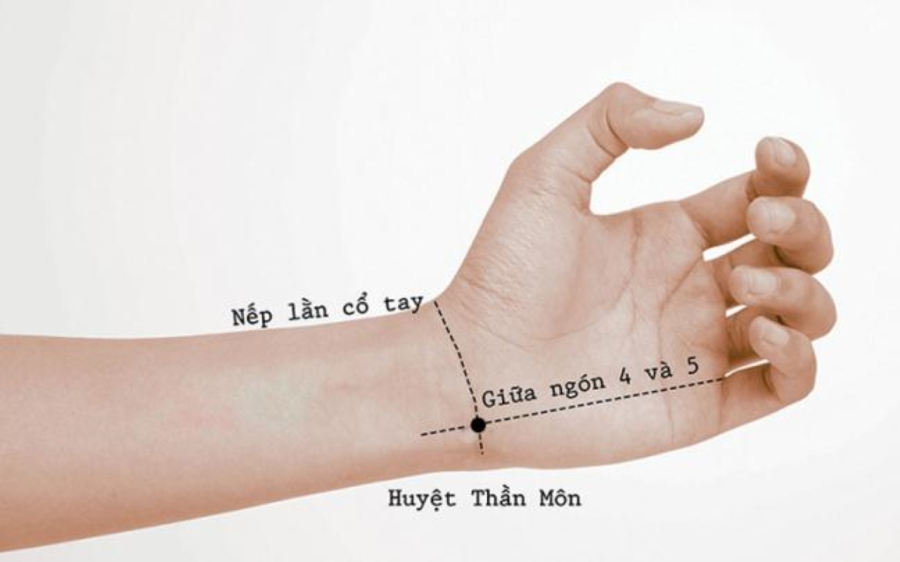Jing Well is the seventh acupuncture point of the Pericardium meridian. According to experts, pressing this point on the wrist can relieve many top symptoms such as heart pain, chest drumming, motion sickness, insomnia, and indigestion…
How to locate Jing Well
Jing Well is located on the wrist, at the intersection of the wrist line and the meridian line from the groove of the little finger to the thumb. The following steps will help you locate it:
Step 1: Place the palm facing up, from the middle groove between the ring finger and the little finger, draw a straight line down to the wrist.
Step 2: Bend your wrist to make the wrist line visible. The point where the straight line intersects with the wrist crease is the location of Jing Well.

Location of Jing Well
Once you have identified the Jing Well acupoint, use your thumb to apply moderate pressure to the acupoint, with the remaining 4 fingers supporting under the wrist.
How to press Jing Well
Press the Jing Well acupoint in a clockwise direction for about 2-3 minutes, then switch hands. You can press the acupoint multiple times, with a 30-second break between each press. The best time to press Jing Well is before bedtime in the evening.
Benefits of Jing Well for health
Traditional medicine records the effects of Jing Well acupoint including clearing Heart heat, clearing fire, calming the mind, invigorating vitality, and harmonizing reversed Qi. Therefore, stimulating this acupoint can be highly effective in treating the following conditions:
1. Regulating cardiovascular function and related heart conditions such as heart pain, discomfort, and chest palpitations.
2. Relieving nervous tension, stabilizing the mind, and reducing restlessness, anxiety, and uneasiness.
3. Preventing motion sickness: Experts believe that people with weak digestion are prone to motion sickness due to difficulty digesting food. If you experience motion sickness, you can press the Jing Well acupoint, which can help stabilize the blood in the stomach, thereby alleviating motion sickness symptoms.
4. Insomnia and sleep disorders: Emotional instability is one of the main causes of difficulty sleeping, insomnia, and shallow sleep. By stimulating the Jing Well acupoint before sleep, you can improve your sleep quality and have a better night’s rest.
5. Indigestion and constipation: Jing Well is the root point of the Heart meridian, and according to the five-element theory, the Heart belongs to fire, while the spleen and stomach belong to earth, and fire generates earth. Therefore, pressing the Jing Well acupoint can promote blood supply to the liver and stomach, thereby improving digestion and reducing constipation.
6. Relieving chest tension: Stimulating the Jing Well acupoint helps replenish vital energy, thereby improving chest tightness.
7. Improving symptoms during menopause such as rapid heartbeat, insomnia, palpitations, sweaty palms, chest pain, and nervous exhaustion…
8. Preventing age-related cognitive decline: After the age of 50, you can press the Jing Well acupoint more often to prevent age-related cognitive decline. By pressing the acupoint more frequently, you can enhance the energy supply to the heart. If the energy of the heart is sufficient, the risk of developing Alzheimer’s disease will be reduced.
9. Alleviating gastroesophageal reflux disease: Stress can overstimulate the sympathetic nerves, leading to excessive acid secretion in the stomach, resulting in gastroesophageal reflux. Pressing the Jing Well acupoint can balance the autonomic nervous system, relieve emotions, and help eliminate issues related to gastroesophageal reflux disease.
10. Balancing the autonomic nervous system: The Jing Well acupoint has the function of soothing the nerves and regulating the autonomic nervous system. You should press this acupoint for 10 seconds, rest for 5 seconds, press each hand for about 5 minutes, and press the acupoint once a day in the morning, noon, and evening.






































